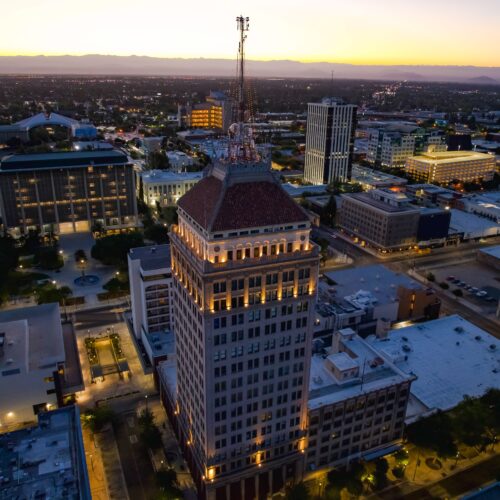Why the State of California is responsible for the public defense crisis in Fresno County

Pleading the Sixth: In late September 2013, more than 80% of the public defenders in Fresno County, California signed a letter protesting their working conditions, and in particular their excessive caseloads. Though some counties in California are rightfully recognized for their “best practice” approach to indigent defense services, the 6AC explores how the failure of the State of California to provide any oversight of the right to counsel services has led to a proliferation of broken systems, like Fresno County’s, throughout the state. It is long past time to put a spotlight on undue political interference in California.
“We are discouraged and demoralized due to the decimation of staff, greatly increased caseload, lack of training, lack of mentoring, and refusal to promote anyone beyond [a mid-level attorney position] within the past five years.” Thus concluded a letter signed more than 80% (41 of 51) of the attorneys working in the Law Office of the Public Defender for Fresno County and sent on September 20, 2013, to the office’s chief public defender. The letter was then forwarded to the county Board of Supervisors and to the presiding judge of the Superior Court, as first reported in the Fresno Bee.
The letter asks the county to immediately address the fact that attorneys are over-burdened with a “staggering number of cases” that puts their clients in “imminent harm” of receiving ineffective assistance of counsel. It should be noted that the staff took its collective approach to notifying the county of the crisis because all are concerned about “being singled out for punishment should an individual complaint be voiced due to the recent termination of an attorney colleague” who refused to take on any more cases.
The letter sets out some of the most flagrant violations of nationally recognized standards of justice that this author has seen in his career, beginning with excessive caseloads.
A closer look at Fresno County’s excessive caseload
As frequent readers of this blog know, all national standards point to the caseload maximums prescribed by the National Advisory Commission on Criminal Justice Standards and Goals (NAC), a 1973 U.S. Department of Justice-funded initiative, and which the American Bar Association’s Ten Principles of a Public Defense Delivery System say “should in no event be exceeded.” For felony attorneys, the NAC standards state that an attorney should handle no more than 150 felonies annually, and nothing else. That is, she does not have any supervisory responsibilities, nor handles misdemeanors (or other case types), nor engages in any private practice on the side.
Fresno County felony attorneys’ average open cases (that is, those they are actively working at any given time) exceed the annual caseload standards by more than 53%. “The felony attorneys are carrying an average of 230 cases as of July 1st, 2013,” the letter declares, going on to determine that the average felony attorney handles more than 1,000 cases per year (or, 566% above national standards). To put it another way, if each attorney works 2,080 hours per year (40 hours per week multiplied by 52 weeks per year), the Fresno County public defender office averages approximately two hours and five minutes per felony case. That means an attorney has slightly more than two hours per felony case from appointment to initial interview to plea negotiations through all final court appearances, including, if necessary, trial and sentencing, if every single minute of every single working day is spent on case-related matters, and the attorney never takes a vacation, observes a holiday, or engages in professional development.
The situation is just as bad for misdemeanor representation. National standards state that an attorney should handle no more than 400 cases annually, and nothing else – a figure that approximates the number of open pending cases a misdemeanor attorney has at any one time. Annually, misdemeanor attorneys handle approximately 2,000 cases each – a caseload that leaves only slightly more than an hour per case.
With caseloads this excessive, it is not surprising to find high levels of turnover among staff. But as attorneys burn out and leave, they are not replaced in Fresno County. The number of public defender attorneys has decreased since 2009 by 34% (down from 78 attorneys to 51 attorneys) at a time that caseload increased by 16% over the same period. Based solely on the number of cases reported in the public defender FY 2012-13 annual report in comparison to the NAC standards, the office needs 139.5 full time equivalent (FTE) lawyers just to handle felony, misdemeanor, delinquency, and mental health cases before factoring in violations of probation cases, contempt, infractions and other cases that the office handles, such as dependencies (e.g., abuse and neglect). This represents an increase of approximately 88.5 attorneys (a 174% increase from the current staff size):
| Case Type | Cases | NAC | Staff |
| Felony | 11,990 | 150 | 79.93 |
| Misdemeanor | 17,691 | 400 | 44.23 |
| Juvenile | 2,941 | 200 | 14.71 |
| Mental Health | 117 | 200 | 0.59 |
| Total Attorney Staff needed to meet NAC | 139.45 | ||
| Current Attorney Staff | 51.00 | ||
| Difference | 88.45 |
As bad as this analysis is, the situation is actually far worse. Let us keep in consideration that the average attorney spends about two hours per felony case. Now consider that Fresno County is geographically vast (just under 6,000 square miles). For context, that is slightly larger than the entire state of Connecticut. Though a recent court consolidation project now affords that public defenders can reach the courts easily from their office, alleged crimes occur throughout the county. And, the staff investigators positions have been gutted to the point where most attorneys must conduct their own investigations (down from 18 investigators in 2009 to nine today). So, that average of two hours per felony case includes any driving time or needed investigations. Additionally, other support staff positions have also been downsized from six legal assistants to four, leaving most attorneys having to conduct their own legal research and other non-legal tasks. This means that the lawyers in the Fresno County OPD are required to do a greater percentage of the workload on each felony case than would an adequately staffed public defender office.
How it got so bad in Fresno County
In 1976, the California legislature created the Office of the State Public Defender (SPD). Unlike other states with statewide, state-funded public defender offices, the California SPD was originally designed as a state appellate defender office without any trial-related responsibilities. But even this limited vision for a state public defender has not been realized, as SPD was defunded in the 1980’s and now handles only a limited number of post-conviction death penalty cases each year.
That leaves California as one of only seven states that do not contribute any money for non-capital, trial-level right to counsel services.[1] This means that local government must shoulder the entire burden of providing trial-level public attorneys to the poor. For California’s more affluent counties, this has not proven to be a problem for the most part, and some of the most respected public defender offices and assigned counsel systems in the country are in California. San Mateo County, for example, has been recognized as having institutionalized the American Bar Association’s Ten Principles and for providing consistent, zealous advocacy on behalf of the clients they serve. (For those interested in the San Mateo County indigent defense system, the 6AC recommends Norm Lefstein’s, Securing Reasonable Caseloads: Ethics and Law in Public Defense, beginning at page 217.)
However, substantial state restrictions have been placed on California counties over the past 35 years making it difficult for less affluent counties to raise revenues. This, combined with the long list of county government responsibilities, makes it difficult for indigent defense services to rise to the top of the triage list in most of the California counties, especially when the state experiences a deep recession as it did from 2008-2012.
Fresno County suffered greatly from the economic recession. In his seminal work on public defense services in the state, The California Public Defender: Its Origins, Evolution and Decline, Cal-Western Law Professor Laurence Benner explains that the Fresno County Public Defender was asked to take a deep budget cut in 2010. At that point, the office dismantled its training unit, along with its legal research unit, much of its paralegal unit, and supervisory structure. With nothing left to cut, the office started letting younger staff go decreasing staff attorneys from 75 to 48. Only at that point did the office start refusing cases. “The County’s response,” reports Prof. Benner, “was to put all the primary indigent defense services up for sale to the lowest bidder.” On October 20, 2010, the county solicited proposals to privatize services.
The threat of privatizing indigent defense services in California is very real. The number of counties turning to low-bid contracts is expanding throughout California. Benner reports in Presumption of Guilt: Systemic Factors that Contribute to Ineffective Assistance of Counsel in California that 24 of California’s 58 counties (or 41%) use fat fee contracting for primary indigent defense services, with several others employing this delivery method for conflict representation. Attorneys working under fixed rate contracts are generally not reimbursed for overhead or for out-of-pocket case expenses, such as mileage, experts, investigators, etc. The more work an attorney does on a case, the less money that attorney would make, giving attorneys a clear financial incentive to do as little work on their cases as possible. Such contractual arrangements are banned under the ABA Ten Principles (Principle 8).
One for-profit law firm in California has become particularly notorious for advancing flat fee contracting in the state. Though the 6AC has never evaluated the services rendered by this law firm, we note their business model was described as being the “Wal-Mart” of indigent defense services in a 2007 article in The Recorder. “Former employees accused [the law firm] of running a sweatshop that relied on a revolving door of young, undertrained lawyers,” who are allowed to take private cases on the side to augment their low pay. “Like Wal-Mart, [the law firm] is all about generating volume and cutting costs in ways his government-based counterparts can’t and many private-sector competitors won’t.” This law firm is the primary public defender now in eight California counties. It also is the conflict defender in Fresno County.
With such a tangible, substantial threat existing right in its own backyard, the Fresno County public defender got the message to refrain from declaring case overload ever again.
Fresno County problems indicative of California’s independence problem
Like the Fresno chief public defender, most public defenders in California are appointed and serve at the pleasure of their local county boards of supervisors. As San Francisco Public Defender, Jeff Adachi, noted in a July 2013 East Bay Express article highlighting the chief public defender in Alameda County (Oakland), public defenders in California are “reluctant to speak openly on criminal justice matters for fear of angering their bosses, who are often averse to controversy,” and “feel constrained by the fact that they are appointed.” (Mr. Adachi is the only publicly elected Public Defender in California, and has been nationally recognized as leading another one of California’s best indigent defense programs.)
The 6AC has written extensively about the preeminent need for independence of the defense function. In short, as was experienced in Fresno County, California public defenders are oftentimes conflicted because they must balance their ethical duties to provide zealous representation to each and every defendant with their own financial well-being. That is, any attempt to control workload will be met with a real or implicit threat that they will lose their jobs for doing so.
The moment that a defender system triages its ethical responsibilities to its clients, it becomes a slippery slope in which all other of the ABA Principles fall by the wayside. For example, a 2011 assessment performed by the Fresno County determined that the practice of “doing more with less” is well institutionalized at the Fresno Public Defender office and “goes back to the days when the office would recycle used file folders and paper clips that other county departments would throw away.” (As an aside, one of the authors of that assessment, former chief public defender for Fresno and Santa Clara County, Jose Villarreal, wrote an opinion piece in the September 27, 2013 edition of the Fresno Bee stating that the Office of the Public Defender “is in dire need of repair and for the Board of Supervisors to continue to be indifferent constitutes malign neglect.”)
Already in violation of ABA Principles 4 and 5 (lack of sufficient time and operating with excessive caseloads), and having disbanded the training unit (in violation of Principle 9), the next devolution of the office was in regard to attorney qualifications (Principle 6). With more senior attorneys leaving the office, younger attorneys were expected to handle more complex cases. The Defense Attorney II classification in Fresno is designated as an attorney who can only handle misdemeanor cases. But as noted in the September 2013 public defender letter, Defense Attorney IIs are now handling all types of felonies including “life-top cases, three strike cases, complex cases such as home invasion robberies, first degree burglaries, gang allegations, sex crimes, large paper cases including welfare fraud, worker’s compensation fraud and check fraud involving thousand of pages of discovery.”
Finally, though the office, in theory, tries to adhere to having the same lawyer provide continuous representation to defendants from appointment to disposition, the sheer volume of cases prevents it (in violation of ABA Principle 7). An interview with Kathy Marousek-Bird, a senior Fresno public defender, revealed that felony attorneys staff what are called “home courts,” where felonies start and probable cause is determined before being bound over to Superior Court. “We are expected to staff these courts, but they sit five days a week,” this attorney stated. “There has to be some time to actually work cases, and if we have a preliminary hearing or trial then someone else has to be pulled in to cover our calendars. They don’t know the clients. It’s quite chaotic.”
But this is not simply a story about Fresno County. Many public defender offices throughout California have similar issues. For example, in 2009, Nancy Albert-Goldberg – the former project director for U.S. Department of Justice-funded National Study Commission on Defense Services – published Los Angeles County Public Defender Office in Perspective. The report concludes that the Los Angeles County Public Defender (LACPD) “constantly grapples with the conundrum of serving two seemingly opposing constituencies—indigent clients accused of crime and a county government that finances both prosecution and defense of the accused.” The lack of independence of the defense function leads to many problems including LACPD misdemeanor attorneys disposing of “1,200 cases per attorney per year, about three times the recommended national maximum.” Moreover, since “detainees generally meet their public defenders only a few moments before appearing before the judge, many guilty pleas take place without any investigation into the facts or the opportunity for a full-scale interview.”
According to Ms. Albert-Goldberg, LACPD “provides no formal training programs for new attorneys outside of an orientation lasting two to three days,” and that “[n]ew recruits are plunged into courtroom duty almost immediately” in felony preliminary hearings because, according to the County’s chief deputy defender, “they can do the least harm there, since the standard of proof is so low, most people will be bound over, regardless.” The report concludes that the “public’s perception of fairness in the criminal justice system” in Los Angeles County “is damaged by ‘assembly line justice’ in the lower courts where millions of citizens have their first encounter with a system that affords inadequate attention to the individual defendant.”
Conclusion: The time to begin fixing California is now
For years, California has been at the center of the national debate about the value of statewide systems versus county-based systems. Many of California counties’ better public defense systems fear that any attempt to get the state involved will result in their programs getting worse. For example, if the state created an organization to disseminate state money based on counties meeting mandatory standards it would, the argument goes, give those counties that are currently above those standards a reason to cut services to fall to the state sanctioned minimum level of services.
Additionally, some public defenders in county systems are well paid and/or have good retirement benefits, and fear compensation levels will drop with state control. For example, a November 2012 article in the Press-Enterprise, detailing the Riverside County Board of Supervisors’ termination of its at-will chief public defender, notes that the chief defender’s salary was $219,217.00. The 6AC in no way infers that public defenders do not deserve such salaries (they do), but simply notes that there is a personal financial disincentive to moving to a state system (in addition to the financial incentive not to rock the boat or decline new appointments when caseloads are excessive).
Even as the immediate focus of reform should be on Fresno County (click here to read the 6AC letter to the Fresno County Board of Supervisors), state and national advocates need to begin the larger task of reforming all of California’s failing systems. In thinking about where to go with California, the 6AC posits this simple point: in finding the right to the assistance of counsel fundamental and essential to fair trials, the U.S. Supreme Court in Gideon made the provision of right to counsel services an obligation of state governments, not counties, by virtue of the Fourteenth Amendment. Though it is not believed to be unconstitutional for a state to delegate to its counties the state’s constitutional obligations, in doing so a state must guarantee that local governments are not only able to provide such services but that they are in fact doing so. California has no such mechanism and, as a result, counties like Fresno are allowed to do pretty much whatever they want in regards to the right to counsel, knowing that the state will do nothing about it.
Reform of indigent defense services in California should start with the creation of a state organization charged with simply documenting how services are set-up in each county, collecting uniform data on caseloads and other indicators, to determine which counties comply with national standards, like the ABA Ten Principles, and which ones do not. Armed with such data, it might then be possible to determine what should be done to rectify the failing county indigent defense systems without harming those few counties that exceed the parameters of the Principles.


